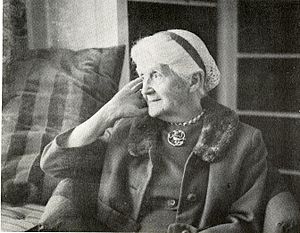Mary Foulke Morrisson facts for kids
Mary Foulke Morrisson (born November 14, 1879 – died March 9, 1971) was an American woman who worked hard for important causes. She was a suffragist, which means she fought for women's right to vote. She was also a social activist, working to make society better for everyone.
Mary Morrisson was a leader in the women's rights movement. This movement aimed to give women the same rights and opportunities as men. She was also a key member of the Board of Trustees at Connecticut College for 28 years. She helped guide the college and support its students.
Mary graduated from Bryn Mawr College in 1899. She studied science like chemistry and biology, and also government. In 1900, she married James William Morrisson. He was the president of a company that sold medicines.
Contents
Mary Morrisson's Work
Mary Morrisson started her public work in 1904. By 1905, she was helping women gain more political power in Richmond, Indiana. She was one of the first social workers in the country. She worked with Jane Addams to create Hull House in Chicago. Hull House was a special place that helped people in need. Mary's work there helped make job conditions better in factories and shops.
Later, Mary Morrisson focused on the suffrage movement. She dedicated her life to helping women win the right to vote. She also became an early supporter of peace. She was part of the National Committee on the Cause and Cure of War. This was the biggest group of American women working for peace in the 1920s.
Working for Peace
The United States government asked Mary Morrisson to speak about peace. She attended important meetings both in the U.S. and in other countries. A big moment in her peace work was in 1928. She represented the U.S. at a conference in Paris. There, she was present for the signing of the Kellogg–Briand Pact. This was an agreement where many countries promised not to use war to solve problems.
Mary Morrisson moved to Connecticut and started the Connecticut League of Women Voters. This group helps people understand politics and encourages them to vote. She also worked at "Connecticut College for Women." She helped advance education for young women there. Mary joined the Connecticut College Board of Trustees in 1937. She was the Secretary of the Board from 1938 to 1965. She also served on state and local boards, including the New London League. She was president of the New London League from 1935 to 1944.
Fighting for the Right to Vote
Mary Morrisson began her work for women's voting rights with Carrie Chapman Catt. Catt was the president of the American Woman Suffrage Association. Mary became the Secretary of the Chicago Women's Suffrage Association from 1912 to 1915. Then, she was its President from 1915 to 1919.
In 1916, she organized a big parade in Chicago. This parade was for the National American Woman Suffrage Association (NAWSA). It happened during the Republican National Convention. At this convention, she helped get the first statement supporting women's suffrage into the Republican Party's national plan.
Mary Morrisson was also the recording secretary for NAWSA. She helped raise money by speaking at many events. She spoke in states like Illinois, Indiana, and Iowa.
Founding the League of Women Voters
Mary helped create the League of Women Voters. She held important roles in this group at the national, state, and local levels. She started the Illinois and Connecticut League of Women Voters. She was president of the Illinois League from 1925 to 1928. She was also the first Vice President of the National League of Women Voters.
After working with many others, the 19th Amendment was passed. This amendment gave women the right to vote. In 1920, Mary Morrisson supported the nomination of Herbert Hoover at the Republican National Convention. This was the first American election where women could vote.
In 1960, Mary Morrisson appeared on a CBS News show called "Women And The Vote." This show was a documentary about how women got the right to vote. It also showed what voting meant for women in American politics. A CBS News producer called her "an invaluable asset." He said she helped bring the passion and victories of the suffrage movement to life for viewers.
Awards and Recognition
Mary Morrisson received several honors for her hard work:
- In November 1944, she was given The Connecticut Medal for Distinguished Civilian War Service.
- In 1946, the U.S. Navy gave her The Civilian and Military Certificate of Appreciation. This was for her recreation work in Groton.
- She received the Jane Addams Memorial Medal.
- She also got The Distinguished Citizen Award from the Men's Club Beth El, Newon.
- In 1960, Connecticut College named her an Honorary Alumni.
Mary Morrisson's Legacy
Mary Morrisson's work continues to inspire people today.
- In 1965, the Connecticut League of Women Voters started the Morrisson Internship Program. This program offers summer internships for Connecticut College students. They work at the League of Women Voters headquarters in Washington, D.C. This internship honors Mary's important work with the League of Women Voters during the suffrage movement.
- The Mary Morrisson School in Groton is named after her. This is because of the great recreation work she did in Groton, where she lived for 60 years.
- The Mary Foulke Morrisson House at Connecticut College is also named after her. This shows her dedication to helping the college grow.
- There is also an annual lecture series named after her: the "Mary Foulke Morrisson Lectureship." It focuses on foreign policy.


